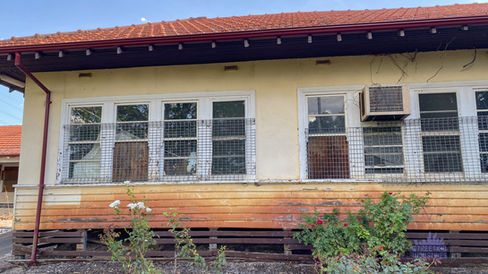
Edward Millen Heritage Precinct
Rear Building
A new chapter began in 1982 when the site was repurposed as the Hillview Child and Adolescent Clinic, a government-run psychiatric service for children and teenagers aged 8 to 18. In practice, many children were admitted at their parents’ insistence rather than by choice. The facility had three parts: an outpatient clinic, a six-bed residential unit called the W.E. Robinson Unit and a 12-bed residential ward known as Hillview Hospital.
Hillview provided care for young people dealing with serious emotional and psychological challenges. It was often linked to abuse, grief, trauma, eating disorders or suicidal thoughts. Stays lasted on average four months, during which patients continued their schooling at nearby primary and secondary schools.

Mildred Creak Clinic
Dr Eleanor Mildred Creak (1898–1993) was a pioneering British child psychiatrist. Trained at the University College London, she became a Quaker (member of the Religious Society of Friends) in her youth and overcame significant gender bias in medicine. After World War I, she struggled to find hospital work as a woman but in 1924, she won an appointment at The Retreat in York (a Quaker-run mental hospital). She later spent a Rockefeller fellowship in the United States, working with early leaders in child psychiatry (including Leo Kanner).
After serving in the Royal Army Medical Corps during World War II, Creak was appointed as the first physician in charge of the new Psychological Medicine department at Great Ormond Street Hospital for Sick Children (GOSH) in 1946. At GOSH she effectively founded paediatric psychiatry as a respected specialty, earning a reputation for her clinical insight into childhood disorders and her collaborative work with paediatricians.
Creak’s most lasting legacy lies in autism research. In the early 1960s she chaired a Spastics Society working party that produced one of the first formal diagnostic checklists for childhood autism. Together with colleague Gerald O’Gorman, she published a nine-point criteria (1961) detailing core autistic traits, such as profound social impairment, preoccupations with sameness, sensory anomalies and delayed or echolalic speech (when a person repeats words or phrases they‘ve heard).
Her work helped to shift professional and public understanding away from parent-blame and towards a biological model. In recognition, a children’s autism unit in Perth, Western Australia was later named in her honour.
Mildred Creak Centre
The Edward Millen, a heritage-listed former hospital in East Victoria Park, housed the state child and adolescent psychiatric services during the 1980s–1990s. The Commonwealth transferred the site to the WA Mental Health Department in 1982.
It was repurposed as the Hillview Child and Adolescent Clinic (also known as Hillview Terrace Clinic). Outpatient services and two residential wards, consisting of the 6‑bed W.E. Robinson Unit and a 12‑bed Hillview Hospital ward, were established there. These units cared for children (aged 8–18) with serious emotional or behavioural disorders, often related to trauma, abuse or acute psychiatric needs. Patients at Hillview typically continued schooling at nearby public schools during their stay.
In parallel with Hillview’s general psychiatric program, the WA government established the Mildred Creak Centre on the same grounds in 1982, to specifically support autistic children. It opened under the leadership of Perth psychiatrist Dr W. E. Robinson (after whom the 6-bed Robinson Unit was named after) and was one of the first dedicated autism assessment and treatment services in Western Australia. The Mildred Creak Centre provided diagnostic evaluations, therapy and family support for children on the autism spectrum at a time when very few public services existed for autism.
By 1994 the Hillview/Mildred Creak clinic was widely regarded as a model service (with average inpatient stays of about four months).

The End of an Era
However, problems began to emerge at the Hillview site by the mid-1990s. A 1995 official review documented serious management and staff failures at Hillview, including inappropriate staff conduct and record-keeping issues. This led the government to close the psychiatric wards later that year. All Hillview patients were transferred to other services (mostly to Bentley Hospital) and the child psychiatric service was terminated.
As one heritage report notes, by 1995 “only the autism [service] remained” on the site. The Mildred Creak Centre outlasted Hillview’s wards by a few years but eventually ceased operations in 2001. When it closed, its functions (assessment and support for autistic children) were absorbed into other state-wide disability services.
In 2006 the land and buildings were handed over to the Town of Victoria Park and they've stood empty ever since, awaiting redevelopment.
Redevelopment plans stalled for years. A breakthrough came in 2023, when Blackoak Capital Ventures signed a 20-year lease with the Town. Their vision is to restore and revitalise the heritage-listed Edward Millen buildings and surrounding parkland, transforming the site into a lively hospitality and community hub. Plans include a café, bistro dining, gastro pub, event and function spaces, a bakery, a farmers market, and even childcare facilities.
.png)



























